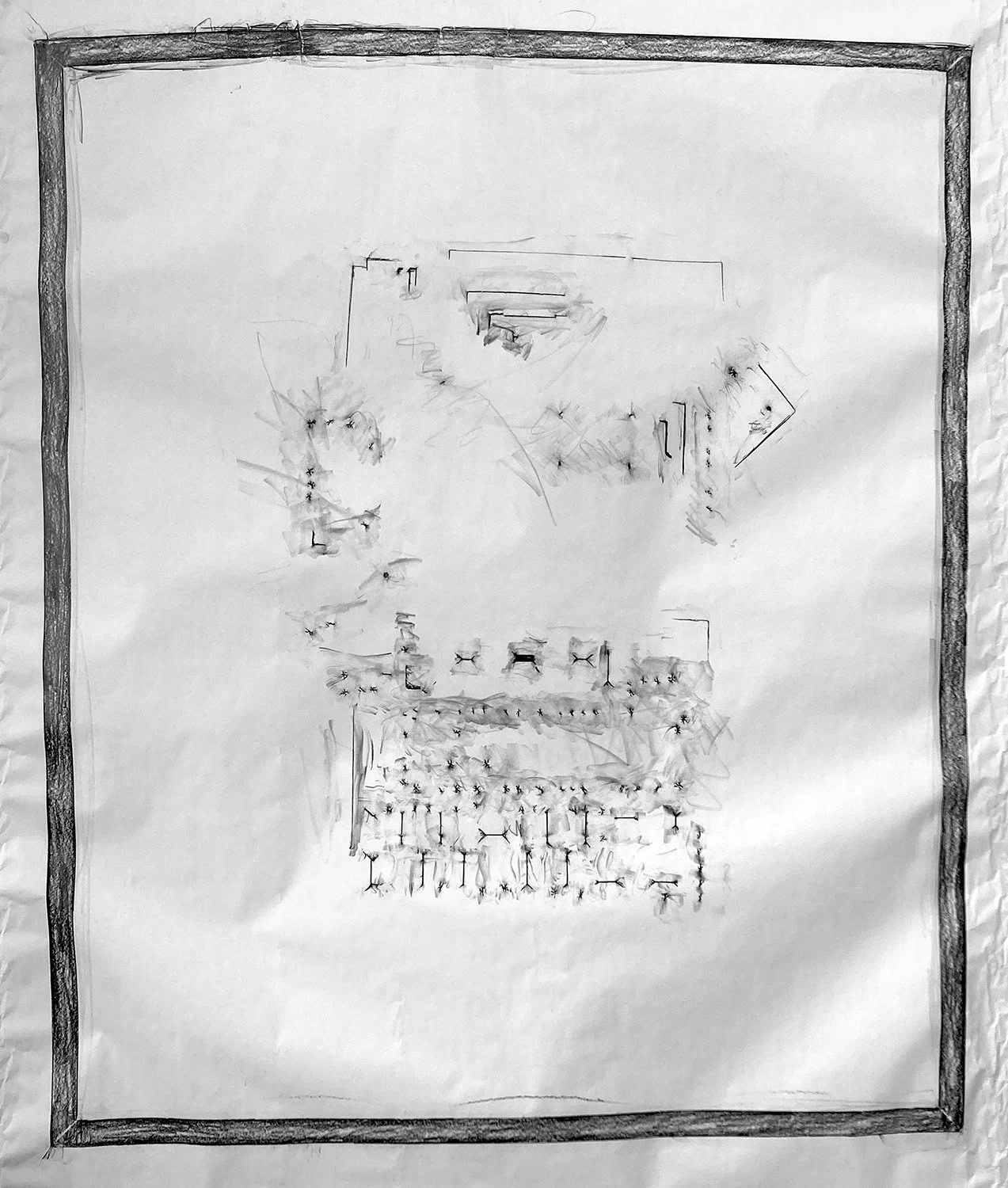Karen Schiff
BORDERLINES (Ellis Island)
Portal (Entrance), detail, 2025, 17’ sq, carbon transfer and gesso on muslin
curated by Surpik Angelini
October 12, 2025 – January 6, 2026
Opening reception:
Sunday, October 12, 2pm – 5 pm
CLosing DIALOGUE EVENT:
Sunday, January 4, 2026
Hours by appointment; please email: surpik@mac.com or text: 713-805-4207
Closing dialogue event: Sunday, January 4, 2026 (more information to be shared later)
Karen Schiff: borderlines (ellis island)
Essay by Surpik Angelini
October 2025
In Karen Schiff’s presentation BORDERLINES (Ellis Island), the artist’s “transfers” –– drawn and painted recordings of specific floor surfaces and visitors’ maps located inside the restored main building at Ellis Island –– demonstrate her detailed attention to architectural contexts for immigration, and her respect for matter. Schiff recognizes that these surfaces are charged with “being”: not only on a physical level, as registers of the historic place that now is a museum (and emblem) of American immigration. But subliminally, too, images of these places evoke the life experiences of the over 12 million prospective immigrants who walked across those floors during the first decades of the 20th century, and thereby also evoke the life experience of standing now at any of our nation’s most transited borderlines.
These artworks (the largest is approx. 17 sq. ft.) represent a dramatic magnification in scale from the first works I saw by Schiff, a series of incredibly subtle drawings revealing the nature and structure of textured papers (9 x 12 in.). Those fine line drawings analyzed the laid paper’s consistent pattern of creases, pointing out minuscule accidental deviations in its grid which are hardly perceptible to the eye. I have never seen drawings expressing such intimacy with the material support. Looking at them formally, Agnes Martin’s line drawings came to mind, but in Martin’s case, her pencil marks are imposed on the paper. The paper is used simply as a means, exemplifying an expected modernist attitude.
Most contemporary artists, living in a global world, use a “modernist” visual vocabulary, since Modernism, after all, was universally imposed as a lingua franca after centuries of colonial Eurocentric domination. Academically trained artists tend to reproduce their own internalized colonial attitude towards matter, imposing their will on it, allegorically displaying skills that domesticate their material or “matter” –– “matter” here stands for the "wilderness of nature" –– as they craft their art. In other words, raw matter is used simply as a resource to be exploited and manipulated, in art very much like in the extractive activities associated with industrial manufacturing. Ultimately, matter is subjected to human will.
Schiff’s work could be said to be rooted, instead, in a decolonized attitude, or in a quasi-quantum entanglement with matter. In this exhibition, she respects and engages with Ellis Island as a living entity, endowed with its own special attributes, and it talks back, as in the psychoanalytic “transference” between client and therapist. Through her artmaking, Schiff also is in conversation with current materialist theories such as in the recent book Vibrant Matter or the more recent discourse of Object-Oriented Ontology. As a new materialist philosopher would see it, her meticulous, “infrathin” attention to her working material not only addresses its deeper nature, but brings out its stability in the here and now as well as its ability to shift into a chance-ridden activation of the viewer’s multilayered imagination.
The unpredictable qualities of experiencing this work extend to the unpredictability of the work itself. Visitors to the gallery are encouraged to walk on one of the drawings, so that their footprints complete the floor that has been “transposed” from Ellis Island’s entrance lobby. Every visitor viewing the drawings in BORDERLINES (Ellis Island) can leave a visible, albeit ghostly, trace of yet another person crossing the threshold of a national boundary.
to the right of the lobby
On floor: “Portal (Entrance)” carbon transfer and gesso on muslin, 17 x 17 ft.
Please feel free to walk on this floor piece. The prints from your footwear will complete the artwork.
North wall: “Wayfinding (1st floor)” charcoal and graphite on rice paper, 18 x 30 in.
South wall: “In Transit” charcoal and graphite on paper, 52 x 42 in.
NORTH ROOM
to the left of the lobby
South wall: “Passage (After Assessment)” Conté crayons and graphite on rice paper, 8 x 10 1/2 ft.
North wall: “Wayfinding (2nd floor)” charcoal and graphite on rice paper, 18 x 30 in.
SOUTH ROOM
CENTRAL LOBBY
“Wayfinding (3rd floor)” charcoal and graphite on rice paper, 18 x 30 in.
All works created in June 2025 at the Ellis Island Immigration Museum, in New York harbor. “Portal” is a rubbing transcribed from the concrete slabs of the building’s first floor main entryway. “Passage” similarly comes from the floor of the Great Hall on Ellis Island’s second floor, at the space between the assessment interview desk and the Stairs of Separation leading to the admitted immigrant’s next destination. Each of the smaller wall drawings is created from one of the metal maps created for sight-challenged visitors to the museum.
Passage (After Assessment), 2025
Mixed media on rice paper
9 x 12 ft
In Transit (in 3D), 2025
Charcoal and graphite on paper
52 x 42 in.
Wayfinding (I), 2025
Charcoal and graphite on rice paper
18 x 26 in.



